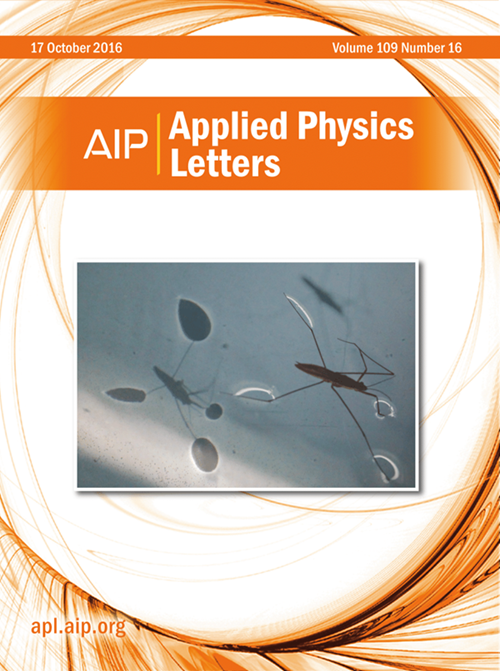Efficient spin–orbit torque driven magnetization switching of GdFe using phosphorus-implanted platinum layers
IF 3.6
2区 物理与天体物理
Q2 PHYSICS, APPLIED
引用次数: 0
Abstract
The capability of the spin–orbit torque (SOT) generated via phenomena such as the spin Hall effect in heavy metals, in switching the magnetization of an adjacent magnetic material, has been studied extensively over the last decade. The efficiency of SOT generation is commonly quantified in terms of the spin Hall angle (SHA). In this work, we demonstrate experimentally that implanting platinum (Pt) with phosphorus (P), resulting in Pt (P) with different implantation doses, increases SHA by a factor of 7, from 0.06 (dose of zero) to 0.43 (dose of 10 × 1016 ions/cm2). The enhanced SHA, along with factors such as perpendicular magnetic anisotropy and resistivity, leads to reduction of the critical current density for switching the perpendicular magnetization of ferrimagnetic rare earth-transition metal alloy Gd26Fe74, by a factor of nearly 27, from 4.0 × 1011 A/m2 (zero) to 1.5 × 1010 A/m2 (10 × 1016 ions/cm2). Furthermore, the switching current density at zero thermal fluctuations and thermal stability factor were evaluated and found to be 2.0 × 1010 A/m2 and 61.4 (10 × 1016 ions/cm2), with the latter being sufficiently above the required threshold for commercial memory applications. Our results suggest that Pt (P) could be a strong candidate in realizing efficient SOT driven magnetization switching, leading to the development of improved memory and logic devices in the future.利用磷化铂层实现GdFe自旋轨道转矩驱动的高效磁化开关
近十年来,人们对重金属中自旋霍尔效应等现象产生的自旋轨道转矩(SOT)在改变邻近磁性材料磁化强度方面的能力进行了广泛的研究。SOT的产生效率通常用自旋霍尔角(SHA)来量化。在这项工作中,我们通过实验证明,将铂(Pt)与磷(P)一起植入,产生不同植入剂量的铂(P),使SHA增加了7倍,从0.06(剂量为零)增加到0.43(剂量为10 × 1016离子/cm2)。增强的SHA,加上垂直磁各向异性和电阻率等因素,导致切换铁磁性稀土过渡金属合金Gd26Fe74垂直磁化的临界电流密度从4.0 × 1011 a /m2(零)降低到1.5 × 1010 a /m2 (10 × 1016离子/cm2),降低了近27倍。此外,对零热波动时的开关电流密度和热稳定系数进行了评估,发现2.0 × 1010 A/m2和61.4 (10 × 1016离子/cm2),后者足以高于商业存储器应用所需的阈值。我们的研究结果表明,Pt (P)可能是实现高效SOT驱动的磁化开关的强有力候选者,从而导致未来改进存储和逻辑器件的发展。
本文章由计算机程序翻译,如有差异,请以英文原文为准。
求助全文
约1分钟内获得全文
求助全文
来源期刊

Applied Physics Letters
物理-物理:应用
CiteScore
6.40
自引率
10.00%
发文量
1821
审稿时长
1.6 months
期刊介绍:
Applied Physics Letters (APL) features concise, up-to-date reports on significant new findings in applied physics. Emphasizing rapid dissemination of key data and new physical insights, APL offers prompt publication of new experimental and theoretical papers reporting applications of physics phenomena to all branches of science, engineering, and modern technology.
In addition to regular articles, the journal also publishes invited Fast Track, Perspectives, and in-depth Editorials which report on cutting-edge areas in applied physics.
APL Perspectives are forward-looking invited letters which highlight recent developments or discoveries. Emphasis is placed on very recent developments, potentially disruptive technologies, open questions and possible solutions. They also include a mini-roadmap detailing where the community should direct efforts in order for the phenomena to be viable for application and the challenges associated with meeting that performance threshold. Perspectives are characterized by personal viewpoints and opinions of recognized experts in the field.
Fast Track articles are invited original research articles that report results that are particularly novel and important or provide a significant advancement in an emerging field. Because of the urgency and scientific importance of the work, the peer review process is accelerated. If, during the review process, it becomes apparent that the paper does not meet the Fast Track criterion, it is returned to a normal track.
 求助内容:
求助内容: 应助结果提醒方式:
应助结果提醒方式:


